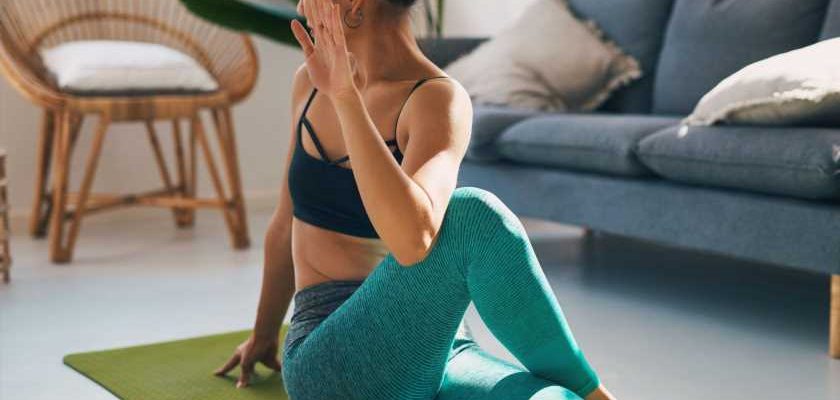This is why your knees and hips are so sore – and what to do about it
Never heard of your IT band? It’s time to get acquainted, as this stretch of tissue could be causing your achey joints.
Many of us are experiencing more aches and pains than ever before, no thanks to three lockdowns, working from home, and now returning to intense workout classes. While those aching knees and tight hips might be caused by issues with the joints themselves, we need to think big picture when it comes to relieving pain.
Our tissue and fascia (the connective ‘cling wrap’ that covers the body) could be to blame. And there’s one particular area that can cause lower body joint aches: the IT band.
You may also like
Feeling stiff and achy? You might want to pay attention to your body‘s fascia
“This piece of connective tissue runs along the outside part of your thigh to connect the hip, knee and shin bones and extends and rotates to help with pretty much all movement,” explains Kerry Dixon, trainer from The Athlete Method.
Kerry explains that the IT band can get irritated and inflamed from overuse, poor technique during exercise and bad posture in our everyday lives – things many of us are guilty of. “Runners who don’t strike the ground correctly will put a lot of pressure on this tissue, but it also exposes other weaknesses you may have, particularly in the glutes.”
What does IT band pain feel like?
A tight IT band may feel stiff during movement or even sensitive to the touch. “You might only notice how tight it is when you’re exercising, such as feeling a constant burning pain in your thighs when running,” says Kerry.
But often, trouble with the IT band is projected in other areas of the body, particularly into the joints that it helps to connect. “It varies from person to person, but it often shows up as knee pain as the tissue runs underneath the knee cap. There can also be a lot of irritation that spreads from the top of the thigh to the hip,” Kerry explains.
You may also like
Stretching: why you should never skip the cool down
How to treat IT band pain
“There are stretches and exercises that you can do to improve flexibility and strengthen the muscles around the IT band so that they absorb the impact of overuse rather than the tissue,” says Kerry.

1. Strengthen the glutes
“Adding side-lying glute raises into your training will take the pressure off the band for the rest of your workout, and it also strengthens the glutes to reduce pain,” says Kerry.
- Lie on your right-hand side, with the right knee bent at 45º and your forearm and elbow on the ground. Keep the body in a straight line from the left toes up to the head.
- Press into your right leg to push your hips up off the ground. Squeeze the glutes at the top of the movement.
- Slowly lower back down to the starting position.
Repeat for 15 reps each side
2. Improve your posture
“A seated spinal twist will stretch out the spine, outside of the hips, shoulders and chest to improve posture and stability. While it doesn’t stretch the IT band directly, it will release pressure everywhere else to then relieve the tightness in the IT band,” says Kerry.
1. Sit on the floor with both legs out straight in front of you. Lift up out of your sit bones so you are tall and your chest is open.
2. Bend your right knee and place your right foot on the outside of your left knee.
3. Hug your right knee with your right-hand side and twist round to your left-hand side. You can place your left hand on the floor for stability.
Hold for up to 30 seconds and repeat on the other side
You may also like
Stretching: 4 stretches to support muscle recovery and prevent injury
3. Stretch the tissue
“You can stretch out the tissue itself too,” says Kerry. “A standing forward fold is the best way to do that, releasing tension and tightness from the muscles in the thighs and the tissue along the outside.”
- Stand with your feet shoulder-width apart, then cross your right foot behind your left, so the outer edge of your right toes is touching the outer edge of your left toes.
- Hinge at the hips to bend forwards over your legs. Bring your chest as close to the thighs as you can.
- To increase the stretch, press your weight into your right foot.
Hold for 30 seconds and repeat on the other side
4. Foam roll
“You’ll find athletes foam roll before and after they run – when I was competing I had my roller tucked under my arm at all times,” says Kerry. “It helps to relieve a lot of tension and encourages blood to the area.”
1. Place your foam roller on the floor. Place your right outer thigh on the roller and your right hand or elbow on the ground, so you are lying sideways.
2. Gently roll up and down the roller from the top of your knee to your hip. You can lift your feet off the ground to get deeper into the IT band.
3. Be careful not to go too far into the hip or the knee, as this can be dangerous.
Repeat for 15 seconds each side
Follow @StrongWomenUK on Instagram for the latest workouts, delicious recipes and motivation from your favourite fitness experts.
Source: Read Full Article
